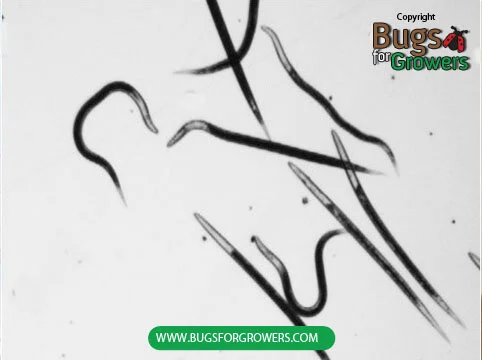What are shore flies?
Shore flies (Scatella stagnalis) are small darkish colored insects that look like small house flies with short antennae and five light spots on each of the forewings. Larvae of shore flies are called maggots that are transparent, without a distinct head capsule and they have eight pairs of short legs.
Damage caused by shore flies
Adults of shore flies do not feed on any plant tissues but they are nuisance to greenhouse workers or visitors and capable of disseminating spores of plant diseases like Pythium and Fusarium oxysporum when they are moving from plant to plant during propagation of young plants in the greenhouses. Larvae (maggots) of shore flies only feed on algae but they do not cause direct damage to ornamental or any other crop plants.
Biocontrol of shore flies with beneficial entomopathogenic Steinernema carpocapsae nematodes
Beneficial entomopathogenic Steinernema carpocapsae nematodes are currently used as excellent biocontrol agents for the control of shore flies. For the effective control of shore flies, apply infective juveniles of Steinernema carpocapsae nematodes (Photo 1) to the surface of the medium on which algae is constantly growing. These nematodes generally use ambush strategy to find their targets. In this strategy, they infect passing insect hosts including larvae of shore flies. They are also known to move around in the medium and find the larval and pupal stages of shore flies and infect them. After locating the host, Steinernema carpocapsae nematodes generally enter into the host’s body cavity using natural openings (mouth, anus and spiracles). In the body cavity, nematodes release their symbiotic bacteria (Xenorhabdus spp.) in the blood of larvae and pupae of shore flies. In blood, bacteria multiply quickly and cause septicemia that kills both larvae and pupae of shore flies within 48 hours of infection this in turn disrupts the reproduction of future generation of shore flies. This reduces the future population of shore flies and damage caused by them in the greenhouses.
Photo 1. Infective juveniles of Steinernema carpocapsae nematodes
Cultural control of shore flies with sticky traps
Flying insects like shore flies are attracted to both yellow and blue sticky traps but shore flies prefer blue colored sticky traps. Although sticky traps are used for monitoring the population of shore flies, they can also help to reduce their population as they get stuck to the sticky traps and die. For trapping a maximum number of flying shore flies, cut blue sticky traps into small pieces, attach them to small wood sticks and place them randomly in the greenhouses. When these traps are completely covered with the trapped shore flies, keep replacing them with new traps until the population of shore flies are completely eliminated.
